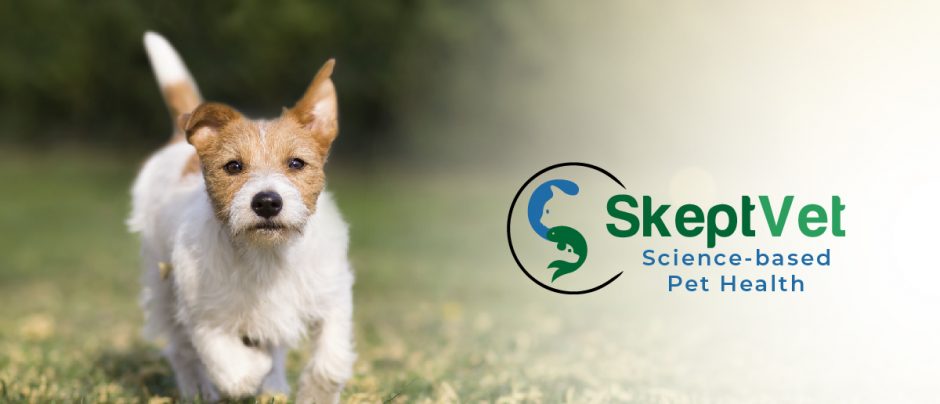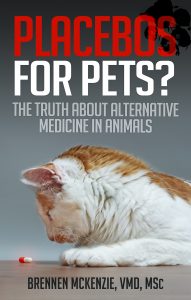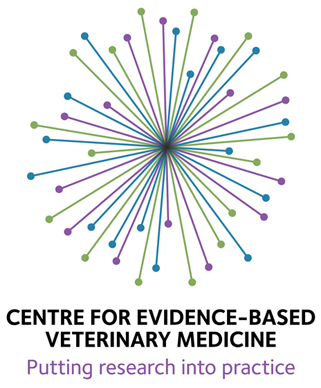The subject of raw diets is a constant and controversial one in veterinary medicine. The controversy stems mostly from the fact that some people are passionately committed to the idea that raw diets have health benefits, but there is no scientific evidence to support this and plenty of evidence showing uncooked food increases the risk of parasitic and infectious disease.
Just this week, there was another series of cases in which people suffered serious foodborne illness due to contact with raw pet food. This is a frequent phenomenon, and there have been many studies in the last 10 years showing raw diets present real health risks to people and pets. There is no comparable body of evidence showing any health benefits. There are, however, a few studies like this that would claim to do so:
Hemida M, Vuori KA, Salin S, Moore R, Anturaniemi J, Hielm-Björkman A. Identification of modifiable pre- and postnatal dietary and environmental exposures associated with owner-reported canine atopic dermatitis in Finland using a web-based questionnaire. PLoS One. 2020;15(5). doi:10.1371/JOURNAL.PONE.0225675
This study comes from the DogRisk group, which I have written about previously-
This is a group of veterinarians and nutrition researchers led by Dr. Hielm-Bjorkman, a faculty member at the University of Helsinki. The organization is independent of the university, and it appears to focus on generating evidence to support raw diets, supplements, and a few other alternative health practices (such as acupuncture). The team is composed mostly of academic researchers, both vets and PhDs, working on issues of animal nutrition. Individually, they have legitimate credentials and research topics, but as a group they seem pretty dedicated to proving a set of pre-existing beliefs about raw diets rather than investigating the subject impartially.
This paper appears to fit into the group’s campaign to validate their pre-existing beliefs about raw diets. The stated goal was to evaluate potential causal factors associated with the presence of allergies in dogs, including the diet of dogs with or without allergies and the diet of the mothers of these dogs. The data come from an online survey of owners, and it is currently only available in Finnish, confining the study to a narrowly limited population not representative of pets or pet owners in other places.
Such online owner surveys are deeply unreliable. The diagnosis of allergies and the details of diet history are based entirely on the recollections and reports of pet owners, most of whom have establishes beliefs about pet health and nutrition and little or no scientific training in these subjects. Many such studies, in human and veterinary medicine, have shown that such information is often biased and not consistent with findings in more controlled research. The authors of this study actually report that almost 13% of the responses had to be discarded because they appeared to be “robot answers,” though it isn’t clear how this was determined. Clearly, this is a dubious source of data to begin with.
The authors compound the problem of reliability by imposing their own arbitrary and biased definitions on the variable they claim to be examining. They divided diet into two extreme categories: 1. A non-processed meat-based diet (NPMD) and 2. An ultra-processed carbohydrate based diet (UPCD). These are artificial categories that reflect the ideological bias of the researchers, not the reality of the kinds of foods dogs are actually fed.
“Non-processed” is meaningless unless the dogs are basically eating whole prey and plants, which it is highly unlikely many of them are doing. The term “ultra-processed” is also a value judgment that implies a negative health impact that has not actually been shown to exist in pet foods. And commercial kibble, which is likely what the authors are referring to here, is not accurately described as “carbohydrate-based.” The carbohydrate content of commercial dry diets varies dramatically, as does the type of carbohydrate (from simple sugars to complex fibers). The nutritional value and potential health effects of commercial diets will also vary greatly based on these differences, and lumping them all together in this artificial category is not a legitimate scientific research approach; it is simply a way of stacking the deck in favor of the result the authors want to get.
The authors claim they are using a validated system of nutritional categories from human nutrition science, known as the NOVA Classification. This system, however, is not meant to apply to pet foods, and the definitions of “processed” used in the system have no relationship to how pet food is prepared. Here’s what the WHO says about the NOVA classification:
A number of commonly consumed processed foods and drinks [are] certainly or probably implicated in obesity and various chronic non-communicable diseases. These include energy- dense food products, “fast foods”, “convenience foods”, soft drinks, sugary drinks, various refined starchy foods, processed meat and salt-preserved foods. [note, none of these categories is relevant to properly formulated commercial pet diets]
Food processing in itself is not the issue. One obvious reason is that nowadays, practically all food is processed in some sense and in some way. The term ‘processing’ (like the term ‘industry’) is very general and therefore not helpful, and so judgements of foods simply because they are ‘processed’ are not meaningful. Food scientists and technologists and food manufacturers are right to emphasize the benefits of originally ancient and also relatively novel processes such as drying, non-alcoholic fermentation, chilling and freezing, pasteurization, and vacuum-packing.
Confusing commercial pet diets with human convenience and snack foods because they are both produced by large industries and come in packages is misleading. The intent and formulation methods are vastly different, and the superficial similarities are not a legitimate foundation for assuming they have the same health impacts.
The NOVA classification also makes no reference to raw or uncooked meat and, in fact, states that, “These methods and processes are designed to preserve natural foods, to make them suitable for storage, or else to make them safe or edible or more pleasant to consume. Many unprocessed or minimally processed foods are prepared and cooked.”
Beginning this study with a distorted misinterpretation of terminology not intended to apply to commercial pet diets is a reflection of the underlying intent and bias behind the research. Other evidence of the authors pre-existing convictions come in the form of discussions of the “natural” diet of dogs as “carnivores” (myths used to promote raw diets which I have addressed before) and irrelevant reference to celiac disease in humans as a way to imply grains are unhealthy for dogs.
There is no apparent attempt to control for these biases in the methodology. The researchers designed the survey, defined the variables of interest, and had total freedom to create and conduct the regression analysis as they chose. It is well-established that such a lack of methodological control for bias leads to research which reflects the beliefs of the researchers more than the underlying reality of nature.
This study was also funded in part by a company selling raw dog food. Funding bias is a known problem in medical studies, and while it is not an excuse for ignoring or dismissing research out of hand, it does require methods built into the study design to limit the impact of funding source on results, which were quite limited in this study. It is also common for proponents of raw diets to claim most veterinary nutrition research is useless because it is funded by pet food companies. It will be interesting to see if this community is consistent in ignoring this paper, which supports their belief, or if they prove interested in funding bias only when it helps dismiss research they don’t agree with.
Bottom Line
This study is a great illustration of ideologically motivated research. A group of scientists committed to a pre-existing belief design and conduct a study tailor-made to provide evidence supporting that belief. The authors do acknowledge some limitations to their project, but they consider them minor and accounted for, and they ignore some of the most significant problems I have mentioned here.
This study fits into a series of efforts by this same research group to validate their belief in the benefits of raw diets, and unfortunately it doesn’t contribute much to actually understanding the pros and cons of raw foods for pets because it doesn’t contain much objective, reliable evidence. It will undoubtedly be useful as marketing r propaganda for proponents of raw diets, and much like research studies done on homeopathy, it confuses rather than clarifies the issue.










What I’d be most interested to see to put this issue to bed, is long-term, large scale feeding trials involving raw diets (potentially different types) and kibble. I do not know of any but surely it is time to see these happen.
Pingback: Book Review- The Forever Dog: Surprising New Science to Help Your Canine Companion Live Younger, Healthier, and Longer |
Again I’m so confused by your take. Pet food companies such as Purina also have are ideologically driven and promote research that already legitimizes their pre-existing beliefs about the ingredients they want to use in their foods. And when no dangers are being shown then they put it on the shelves of pet food stores. So it’s exactly what the Helsinki group is trying to achieve. They’re actively looking to prove that their way is the best way. That’s what science is about. You try to prove the alternative hypothesis. The null is that kibble is isn’t harmful and the best option currently. The alternative is that raw food is more nutritionally dense and thus more appropriate and therefore the better option. If they had started their research in the rarely 1900s like Purina we would have a mountain of date to refer to. And that’s where I see the issue. Someone at some point thought hey let’s make dog food. And that’s how it all started. But up until then dogs ate actual real foods and survived just fine as far as we know. But now all of a sudden we’re dependent on commercial dog food. At times you can seem a bit dogmatic and that bothers me as a genuine reader. Also, unprocessed food just simply means actual whole foods combined into a nutritious meal. It doesn’t mean isolated chemicals from real foods added to a dried piece of kibble that’s then glued together with cellulose or other fillers such as soy and various types of carbs dogs don’t even need. For instance, bread is processed food. We eat it. It’s fine. But technically it’s processed. Smashing an avocado and adding salt and pepper and lemon to eat it like that is not processed. We can apply the same strategy to dog food. It doesn’t have to be so complicated. But reading your articles makes it seem like it is. And you always harp on about what constitutes real food or natural food or unprocessed food without ever defining those terms. We can collectively establish the definitions for these terms and then come up with guidelines to manufacture food that falls within each category.
Of course there is potential bias in all research. However, the Dogrisk folks have a very limited data set rife with bias and from which they continually produce papers “proving” what they already believe with questionable methods. This does describe some industry research, but if you think the entire field of animal nutrition is only pet food company studies as biased and methodologically dodgy as these papers, you are mistaken. There is a large body of evidence of all kinds from many sources going back decades on what mammals in general, and dogs and cats in particular, need nutritionally, and it isn’t all about promoting commercial kibble. This sort of ‘but they are just as bad” (or tu quoque fallacy) doesn’t lend any support to the conclusions DogRIsk is promoting.
Science is NOT about proving “my way is best,” though sadly too many scientists approach it this way. It is a communal process where we take ideas and observations and try to find their flaws and biases, and we only have confidence in a particular claim once there is evidence of multiple types from various sources with different biases that all lead to the same conclusion. Criticism of research isn’t being “mean’ or ‘closed-minded,” it is the core of the scientific process.
“dogs ate actual real foods and survived just fine as far as we know.”
But of course we don’t know this. You simply assume that lifespan and health were as good or better when dogs foraged from our tables or our trashy s they did for millennia and still do in ma ny places, and that somehow commercial foods are worse than this food source. There is no reason to believe that is true and plenty of reasons to believe it isn’t (including the limited evidence for improving life expectancy in dogs over the last several decades and the poor health and life expectancy of feral dogs and many wild canids compared with owned or captive canids).
As for definitions of terms, that’s part of my problem with the work this group does. They use terms like ‘ultra processed” as if they were objective and value-free, but they are really an attempt to imply commercial foods are unhealthy without providing actual evidence this is so.
I’ve said many, many times on this blog that I suspect there will be health benefits to feeding balanced, cooked whole Foods compared to kibble or canned for those who have the time and financial resources to do so. But this doesn’t mean kibble is the horrible poison it is so often portrayed to be, nor does it mean such Whole Foods or raw foods are healthier just because I think they might be. What we need is real research, and unfortunately what DogRisk is producing is simply opinion dressed up as science, and that just confounds our efforts to find out what works best.
The onus should be on pet food manufacturers to prove that their foods are better than a whole food diet, not the reverse. Instead they proved that 6 out of 8 dogs didn’t die after 6 weeks of feeding their food and some blood nutritional levels were sustained. Raw pet food companies are now participating in and passing these trials to earn this highest AAFCO rating. There may be a fault in that system.
I doubt there are many doctors who would recommend people eat only a kibble made for humans over a whole food diet. If a fresh food diet is nutritionally balanced, how could it not be more beneficial for dogs? All the data shows that whole foods are better for humans, why are the rules different for dogs? So many zoos and animal reserves, who observe and record their animals quite extensively, are changing back to whole foods for their animals. Shouldn’t pet owners be following their lead?
As I’ve said before, the idea that dogs eating a properly designed kibble is like people eating only packaged foods ignores the meaningful differences between the two. Whole Foods may be better, but if they are improperly formulated (most homemade recipes are) or if they have a high risk of infectious diseases (most raw foods do), then they could easily be worse than kibble and canned. “Whole food” is not a magical substance with all benefits and no risks, it’s just a different way of feeding that has pros and cons and needs to b studied like any other diet.
I agree the standards for all diets should be higher, but there is far more evidence to support existing diets than new ones, and just because it is “whole” or “fresh” doesn’t mean it should be exempt from the same standards evidence. And most commercial foods don’t make health claims (except for therapeutic diets, which hav to prove these with clinical trials). They claim only not to be nutritionally incomplete, and the evidence for that claim is overwhelming. Fresh and raw diet proponents make all kinds of claims about better health, fewer disease, longer life, and those require a much higher standard of evidence than simply claiming your food won’t cause a nutritional deficiency, which is all most commercial diets claim.
I’m happy to recommend the best diet with the best evidence, but the argument you’re making here is basically, “I think Whole Foods are better and so do other people,” and that isn’t meaningful evidence to change what we feed tens of thousands of dogs who are doing great on their current diets.
Pingback: Is Sunday dog food cooked?: Human-Grade Chicken Recipe 2024